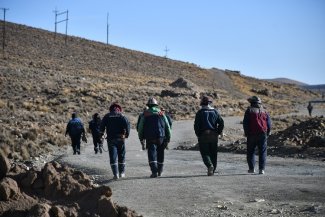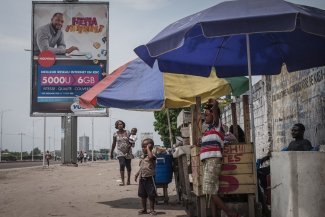
Heavy rains and strong winds are battering a building site in Surat Thani, southern Thailand, and workers huddle under a makeshift canvas shelter, mixing cement by hand. A few months ago the area sweltered in temperatures reaching above 40° C, which even the most hardened of the workers admits was “too much”, and several work hours each day were lost to the heat.
Any hours not worked in the hot season went unpaid, and as the weather cools slightly the workers are now keen to make up lost time and lost wages, even in stormy weather.
“We’re working more than usual now to help the owner get the site ready in time, but also because we need the money,” says 25-year-old Lin who, like many working in insecure construction and agricultural jobs in Thailand, is a migrant from Myanmar.
Working without power tools, Lin shovels sand and pours concrete by hand for up to twelve hours a day, with no more than a 15-minute lunch break. He says there’s not much other work available. But working in these conditions in high temperatures, experts say, is a recipe for disaster.
“Concentration, productivity and ultimately health all suffer in excessive temperatures,” says Rory O’Neill, a professor of occupational health at the University of Stirling in Scotland and editor of Hazards magazine.
“Deaths are not uncommon, with deadly incidents involving young migrant farm workers in the US last year leading to a national prevention campaign by the [federal] safety regulator OSHA [Occupational Safety and Health Administration].”
The deaths of three women working on grape farms in California in July are thought to have been caused by exposure to extreme heat.
The risk to workers is only expected to get worse as climate change raises temperatures and increases the likelihood of extreme weather events. Six new research papers released at a recent United Nations forum in Malaysia say heat stress caused by increasing temperatures is causing serious health and financial problems in many countries.
"Current climate conditions in tropical and subtropical parts of the world are already so hot during the hot seasons that work capacity for many people is affected,” said author Tord Kjellstrom of the Health and Environment International Trust in New Zealand.
Health risks from air pollution can also be worsened by climate change, and at this time of year, the workers in Thailand are also at particular risk from extreme weather, Kjellstrom says, “such as storms and extreme rain with floods.”
“The social impact of discontinued work due to extreme weather may be the most likely effect,” he says. “This is what happened during extreme floods in Thailand in recent years.”
The financial cost of heat stress to national economies is estimated to be huge.
The papers warn of serious productivity losses due to heat stress, estimating that in south-east Asia alone "as much as 15 to 20 per cent of annual work hours may already be lost in heat-exposed jobs," a figure that may double by 2050 as the planet continues to get hotter.
Thailand is thought to have taken the greatest financial hit, with lost labour productivity due to increasing heat costing the country some US$5.4 billion.
Failure to protect the most vulnerable
Despite the enormous costs and dangers, experts warn that businesses and governments worldwide are failing to take appropriate action to protect those working in high temperatures.
“Business should be doing much more,” says O’Neill. “One major problem is that many of the highest risk jobs are concentrated in sectors with the most insecure workforces. Seasonal, migrant farm and construction workers are more vulnerable to employment abuses, from low pay to high temperatures. They are, in the eyes of many employers, disposable labour.”
He points out that it’s not just outdoor workers that are at risk. “Bakeries, factories and foundries can all present dangerously high temperatures in the absence of adequate controls and ventilation. Office workers may suffer concentration lapses that endanger themselves or others.”
He says union organisation and putting an end to exploitative employment practices is needed to “quickly stop employers benefiting from working vulnerable employees into the ground.”
Workers are already organising to improve conditions in the US, where heat has reportedly killed more than 30 workers a year on average since 2003. The International Union of Food Workers (IUF) is working with the Farm Labor Organizing Committee (FLOC) to improve conditions for the thousands of migrant farm workers labouring in hot and dangerous conditions.
“One of the cases that really started their work in tobacco was the death through heat stroke of a Mexican migrant farmworker some years ago,” Sue Longley, international officer for agriculture and plantations at the IUF, told Equal Times.
Last year unions in the US also won compensation for bereaved families of farm workers who died due to heat stress.
“But that’s consolation only. Workers need protection and families need justice,” O’Neill says, “That will only come through collective action and recognition that basic human rights at work are not an optional extra for business, and preventable deaths must never be the price of production.”
“Union walkouts have pressed this message home and quickly won action. Given that a single day in the baking sun can be fatal, it might be your only reliable defence.”
Kjellstrom adds that “improved research and analysis of the [climate change] problem and its solutions is urgently needed” in order to convince business and governments to do more.
If nothing – or not enough – is done, low-paid workers like those on Thailand’s construction sites will feel the most acute effects of climate change.
“Without effective prevention policies and actions, these construction workers will face increased health risks due to excessive heat. The number of work hours in the hot season will be reduced, and the workers may end up with much less income.”
“We must take decisive action now to mitigate emissions of greenhouse gases,” he stresses. “Failure will cause the frequency and intensity of disasters to worsen dramatically beyond 2050, and the situation at the end of this century will be especially alarming for the world’s poorest people.”








